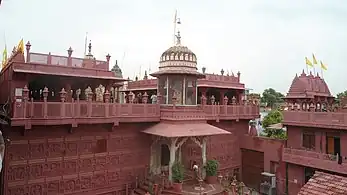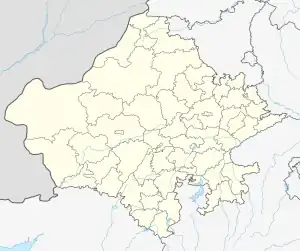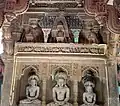Sanghiji
Shri Digamber Jain Atishya Kshetra Mandir, Sanghiji is an ancient Jain Temple in Sanganer, Rajasthan made of red stone. The ancient Shri Digamber Jain temple of Sanganer is 16 km from Jaipur.
| Shri Digamber Jain Atishya Kshetra Mandir, Sanghiji | |
|---|---|
 Sanganer Temple | |
| Religion | |
| Affiliation | Jainism |
| Sect | Digambar |
| Deity | Rishabhanatha |
| Governing body | Management committee Shri Digamber Jain Atishaya Kshetra Mandir |
| Location | |
| Location | Sanganer, Jaipur, Rajasthan |
 Sanghiji | |
| Geographic coordinates | 26°48′54″N 75°47′10″E |
| Architecture | |
| Style | Nagara architecture, Māru-Gurjara architecture |
| Temple(s) | 1 |
| Website | |
| sanghijimandir | |
| Part of a series on |
| Jainism |
|---|
 |
History
%252C_RP-F-F02504.jpg.webp)
This temple is a major Jain pilgimage center.[1] The idol of the principal deity of this temple, Lord Rishabhanatha (Adinatha), the first Tirthankara, is supposed to be 4000 years old.[2] The last phase of this temple was completed in the 10th century A.D., according to the inscription of V.S. 1011 in one of the Toranas.[3]
About temple
In the underground portion, there is located an ancient small temple guarded by the yaksha, nature spirits. The sacred temple has seven underground floors which are kept closed due to old religious beliefs and visitors are not allowed to see them. It is said that only a Balyati ascetic Digambara saint can enter it and can bring out the idols of this underground temple for a limited period, which is declared and decided previously.
The temple also has a dharamshala equipped with all modern facilities, including bhojanalaya (a restaurant).[4]
Architecture
The Jaina temple follows Nagara architecture. The temple features a highly decorated arched entrance.[5] The temple has a double storey gateway with first storey sumounted by an Nagara style arched Shikhara.[6]
The temple features a sky-high shikharas and the inner sanctum is a stone shrine with eight sky-high shikharas (pinnacles).[7] Sanghiji temple is considered a great specimen of Hindu and Jain architecture. The larger shrine was built using marble and sandstone in the 10th century and the smaller shrine is rich with ornate carvings of the temple; using the white marble is comparable to that of Dilwara Temples in Mount Abu.[3][8][9][10]
The decorative features such as flying arches, bracket figures, carved pillars, and lotus ceilings are a feature of Māru-Gurjara architecture.[11]
Idols
The inner temple has three pinnacles; in the centre is an idol of Parshwanath with seven serpent hoods. All around it is carvings of lotuses, creepers and elephants pouring water from pitchers held in their trunks. The main idol is that of Adinath, installed in the shrine behind this.
In 1999, Muni Sudhasagar visited the temple and brought thirty-nine valuable Jain idols. He claimed that he brought the idols from the fourth underground floor and encountered many yakshas (in the form of snakes) protecting the treasure.[9]
Gallery
 Front Vedi
Front Vedi Shikhar
Shikhar Rishabhanatha idol
Rishabhanatha idol.jpg.webp) Murals on the wall
Murals on the wall
References
Citations
- Glynn 1996, p. 92.
- Shri Digamber Jain Atishaya Kshetra Mandir, Sanghiji, Sanganer, Jain Teerth, archived from the original on 27 February 2019, retrieved 13 September 2015
- Coolidge 1879, pp. 161–162.
- IGNCA & Dharmashala.
- IGNCA, p. 1.
- IGNCA & Gateway, p. 1.
- Qvarnström 2003, p. 372.
- Titze 1998, p. 142.
- Parihar 2000.
- Rajputana Agency 1879, pp. 161–162.
- Hegewald 2015, p. 122.
Books
- Coolidge, Archibald Cary (1879). The Rajputana Gazetteer. Gazetteer of India. Vol. 2. Rajasthan: Office of the Superintendent of Government Print.
- Titze, Kurt (1998). Jainism: A Pictorial Guide to the Religion of Non-Violence (2 ed.). Motilal Banarsidass. ISBN 978-81-208-1534-6.
- Qvarnström, Olle (2003). Jainism and Early Buddhism: Essays in Honor of Padmanabh S. Jaini. Jain Publishing Company. ISBN 9780895819567.
- Rajputana Agency (1879). The Rajputana Gazetteer. Vol. 2. Office of the Superintendent of Government Print.
Web
- Glynn, Catherine (1996). "Evidence of Royal Painting for the Amber Court". Artibus Asiae. 56 (1): 67–93. doi:10.2307/3250105. JSTOR 3250105. Retrieved 7 May 2022.
- Hegewald, Julia A. B. (2015). "THE INTERNATIONAL JAINA STYLE? Māru-Gurjara Temples Under the Solaṅkīs, throughout India and in the Diaspora". Ars Orientalis. 45 (20220203): 114–140. doi:10.3998/ars.13441566.0045.005. JSTOR 26350210.
- Parihar, Rohit (11 December 2000). "Digambar monk's rebuilding mission divides Jains". India Today.
- "Sanganer". Rajasthan tourism.
- Indira Gandhi National Centre for the Arts
- IGNCA. "Mandir Shri Digamber Jain Mandir" (PDF). Indira Gandhi National Centre for the Arts. Retrieved 8 May 2022.
- IGNCA. "Gateway of Shri Digamber Jain Atishya Shetra Mandir (Sandhi)" (PDF). Indira Gandhi National Centre for the Arts. Retrieved 8 May 2022.
- IGNCA. "Jain Dharmashala" (PDF). Indira Gandhi National Centre for the Arts. Retrieved 8 May 2022.